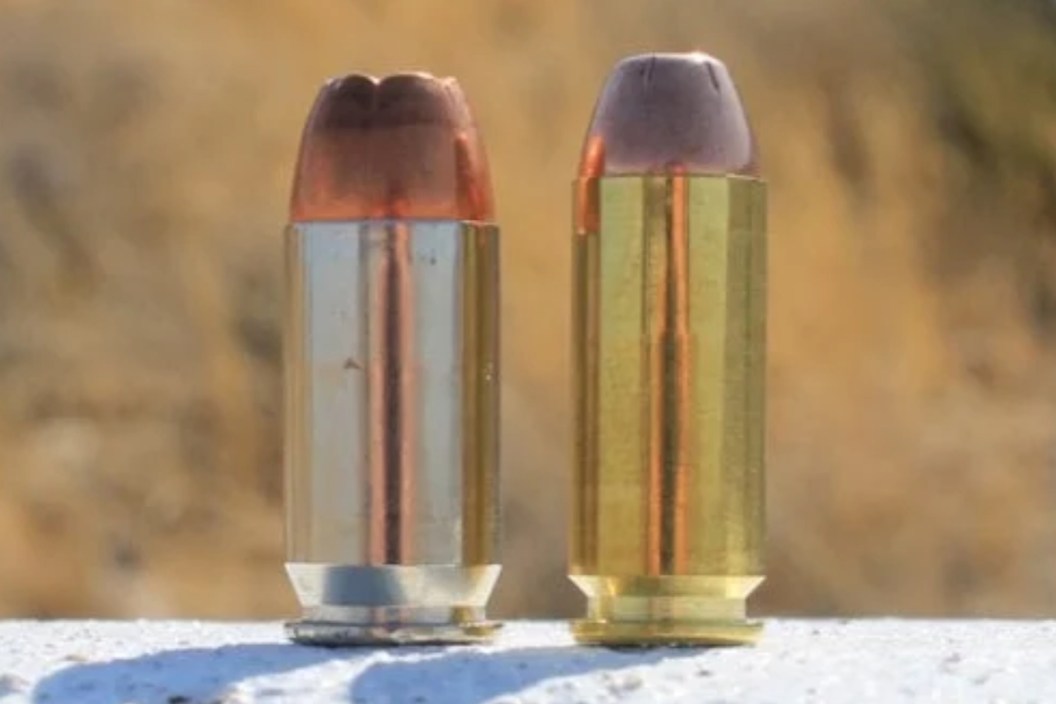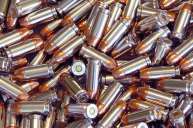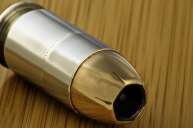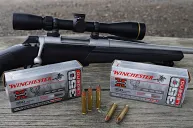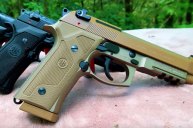If you want a powerful cartridge with an established track record for your semi-auto handgun, it really comes down to two choices.
They're both great, so I think we can agree that choosing between the 10mm Auto and the .45 ACP can be a difficult proposition. So, why not buy a handgun chambered in each cartridge? If that's an option for you, then by all means, go ahead and do it!
But, even if you do own both a 10mm Auto and a .45 ACP handgun, how do you know what to use each for?
While there is a bit of overlap in their capabilities, the designers of the 10mm and .45 ACP prioritized very different characteristics and traits in a handgun cartridge. Not surprisingly, the 10mm and .45 ACP each reflect the priorities the designers had, and therefore have distinct strengths and weaknesses.
In this post, I am going to help you decide which one is best for you.
.45 ACP: John Browning's Masterpiece
Conceived more than 100 years ago by renowned gun designer John Browning, the .45 ACP is the elder statesmen of the two cartridges. In keeping with the prevailing attitudes on handgun cartridges in that era, Browning designed the .45 ACP to shoot a big, slow bullet that was an effective "man-stopper" when using full metal jacket ammunition. He was very successful in that regard.
The typical .45 ACP load is a 230-grain bullet fired at 830 fps for about 355 foot-pounds of muzzle energy. At short range, that hard-hitting load was considered the gold standard for stopping power among handguns for many decades. Similarly, when shooting modern jacketed hollow-point ammo, the .45 ACP is even more effective than it is with FMJ ammunition.
Armed with the legendary 1911 pistol, American soldiers, sailors, airmen, and Marines used the .45 ACP in World War I, World War II, Korea, Vietnam and countless smaller conflicts all over the globe to this day. The cartridge has also been very popular among law enforcement officers, shooters and hunters in the United States for the past century.
The 1911 is still the most popular .45 ACP handgun out there. In addition to surplus government 1911s, Colt, Dan Wesson, Kimber, Remington, Rock River, Sig Sauer and Springfield (among others) all currently produce variants of the 1911 handgun.
If you don't want a 1911, you have other options, like Glock's lineup of .45 ACP handguns: the Glock 21 (full-size), 30 (compact), 36 (subcompact) and 41 (competition). The same goes for the H&K45, the Ruger American, SR45 and the Springfield XD.
Though it's not for the recoil-shy, most shooters can handle the cartridge without too much trouble. Competitive shooters use the .45 ACP extensively for target shooting because it's so accurate. Additionally, just about every ammunition manufacturer produces ammo for the cartridge, so .45 Auto rounds are pretty inexpensive and easy to find.
10mm Auto: Jeff Cooper's Bold Innovation
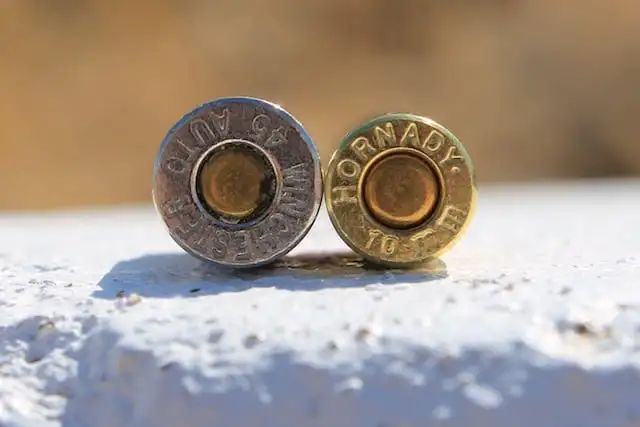
Aside from the relatively uncommon .38 Super, most shooters only had two choices for semi-automatic handgun cartridges in the 1970s and 80s: the 9mm Luger and the .45 ACP. While the .45 ACP went the "heavy and slow" route, the 9mm Luger took the opposite tack by shooting much lighter bullets at a higher velocity.
Though he preferred the .45 ACP over the 9mm, the celebrated gun writer Jeff Cooper still wasn't satisfied with just those two choices. So, he worked with the Swedish ammunition company Norma A.B. to build what he considered the ideal combat handgun cartridge.
The result was the 10mm Automatic: a medium-bore cartridge that really packed a punch. Introduced in 1983, original loads shot a .40-caliber, 200-grain bullet at 1,200 fps for a whopping 759 foot-pounds of muzzle energy.
Designed in conjunction with the 10mm Automatic cartridge, Dornaus & Dixon Enterprises' Bren Ten was the first pistol chambered in 10mm Auto. The Bren Ten initially exploded in popularity, but the company suffered a number of production issues (especially with magazines) and Dornaus & Dixon went bankrupt after just a couple years in business.
Since there were no other 10mm pistols in mass production at the time, the demise of the Bren Ten and its parent company nearly ended the 10mm story before it really got started. However, Colt started building a 1911 modified to shoot the new 10mm cartridge called the Delta Elite. Glock followed up on the success of the Colt Delta Elite by releasing the Glock 20 handgun a few years later.
Compared to the .45, shooters don't have as many 10mm pistols to choose from, but there are still some really good options out there. The Colt Delta Elite is still available in limited quantities. Glock's G20 and the long-slide G40 released in 2015 are both pretty popular among hunters and shooters. Though they're far from the only other choices, Kimber produces a couple different 10mm handguns, Sig makes the P220, Razor Dobbs likes to hunt with a Dan Wesson Razorback, and Ted Nugent sometimes uses a Wilson Combat Hunter,
Briefly adopted by the FBI the late 1980s, the reduced-power 10mm Auto loads (dubbed 10mm FBI or 10mm Lite loads) were created because some agents had difficulty handling the cartridge's stout recoil. Smith & Wesson eventually developed a shortened cartridge with capabilities almost identical to the 10mm FBI loads that are now known as the .40 S&W.
You can still find full-power 10mm ammo out there, but these lower-power loads are relatively prevalent as well. Even so, the 10mm Auto is still the most powerful semi-automatic handgun round in widespread use (aside from uncommon cartridges like the .475 Widley Magnum and the .50 AE).
The flat-shooting and hard-hitting characteristics of the 10mm Auto make it very effective hunting for deer-size game. It's great in a self-defense role, and it's also a passable bear-defense cartridge.
One the other hand, all that power does come at a cost. While it's not a hand cannon by any means, the 10mm does have more recoil than a lot of other cartridges. That being said, the 10mm recoils only a little more with than the .45 ACP. So, well-trained shooters using good quality handguns can handle it without much trouble.
Additionally, 10mm ammo isn't extremely common. Barnes, Buffalo Bore, Double Tap, Federal, Hornady, Remington, Sig Sauer, Underwood and Winchester all make 10mm ammo, so there are numerous 10mm options for practicing, self-defense and hunting, just not as many as there are with other cartridges like the 9mm Luger and the .45 ACP. By the same token, 10mm Auto ammunition is normally a little more expensive as well.
10mm vs 45 ACP: Which One's Best for You?
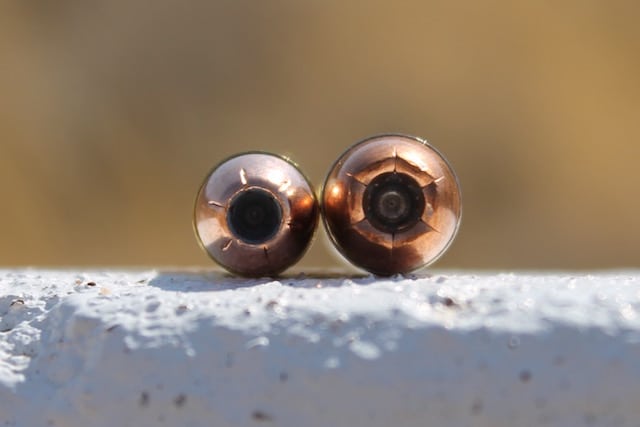
So which one should you buy?
Just like with most things, it's really a matter of what you intend to use your handgun for.
The 10mm Auto devotees point out that the 10mm has more energy remaining at 100 yards than the .45 ACP does at the muzzle. Fans of the .45 ACP counter that the .45 is bigger at 100 yards than the 10mm is at the muzzle.
However, those statements also reflect the strengths, weaknesses and ideal uses of each cartridge.
The .45 ACP is an outstanding choice for self-defense. When using high-quality ammo at short range, the .45 is undoubtedly one of the best semi-auto handgun cartridges out there. It's also much easier to handle in a compact or subcompact handgun than the 10mm, which makes it a better choice for concealed carry. The milder recoil of the cartridge also makes it easier to take rapid follow-up shots.
The lower cost of .45 ACP rounds also makes the cartridge a better choice than the 10mm for general plinking.
On the other hand, the 10mm Auto is the clear winner if you want to hunt with a handgun. It shoots a lighter bullet at a much faster muzzle velocity than the .45. Not only does this translate into more kinetic energy, but the cartridge also has a flatter trajectory than the .45. Correspondingly, this makes it easier to take longer-range shots.
Those hot 10mm loads also hit harder, make larger wound channels, and dispatch game faster than the .45 ACP. Heck, even the .45 ACP +P load by Buffalo Bore in the table above isn't even in the same league as the run-of-the-mill 10mm Hornady XTP load.
For these same reasons, it's a better cartridge to use than the .45 ACP for self-defense against large four-legged predators, too.
That's not to say that the 10mm won't work when used in self-defense against a human assailant, but just keep the downsides of the cartridge in mind before you decide to use it in that role.
The 10mm is much harder to handle in smaller-framed handguns popular for concealed carry. In addition to the fact the cartridge has more recoil than the .45, over-penetration is a concern with the 10mm. These issues are less of a problem in a home-defense situation, though, particularly when using high-quality defense rounds.
Regardless of which cartridge you pick, test out a couple of different handguns and choose the one that fits you and your needs. Use high-quality ammunition and spend plenty of time at the range. As long as you do your part as the shooter, neither the 10mm Auto nor the .45 ACP is likely to let you down.
Like what you see here? You can read more great articles by John McAdams on The Big Game Hunting Blog. Follow him on Facebook, Twitter, YouTube, & Instagram.
READ MORE: TOP 6 SELF-DEFENSE HANDGUNS FOR WOMEN
